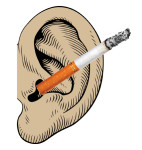8 Sun Protection Tips for Children’s Skin
Posted on June 30, 2014 by bob in NewsUCanUse
8 Tips to Protect Children’s Skin in Summer
–Apply water-resistant sunscreens with UVA and UVB protection labeled 30 SPF or higher.
–Apply 20-30 minutes before exposure.
–Reapply at least once an hour.
— Apply extra sunscreen with zinc oxide or titanium oxide to nose and lips.
— Talk with camp counselors to make sure they apply or supervise the application of sunscreen.
— Keep babies younger than six months out of the sun. Sunscreen can irritate, and their eyes are especially vulnerable to sunlight.
— Make sure your child wears sun-protective clothing with a listed Ultraviolet Protection Factor (UPF).
— Limit outdoor playtime when the sun is at its strongest (10am-3pm).
(Newsroom, June 2014. Provided by Cincinnati Children’s Hospital Medical Center)
 E-Cigarettes on Fire
E-Cigarettes on Fire
E-cigarettes vaporize nicotine, the addictive ingredient in tobacco products. They first became available in the U.S. in 2007. Now, the first comprehensive survey of on-line sales of e-cigarettes found 466 e-cigarette brands sold online in 7,700 flavors, including candy flavors that may appeal to children, such as gummy bear and marshmallow. Traditional cigarettes sold in the U.S. can be marketed in just two flavors: tobacco and menthol.
Customizable e-cigarettes can look nothing like an old-fashioned tobacco cigarette, with some resembling pens and flashlights. The marketing messages for the older vs. newer e-cigarette brands are different. Older brands were more likely to claim e-cigarettes were healthier or cheaper than smoking, or that e-cigarettes could help people quit smoking. Newer brands focus their marketing message on consumer choice, such as flavors or models.
Smoking rates among American adults have declined from 42 percent in 1965 to 18 percent in 2012, but tobacco use in the U.S. is still responsible for nearly one in five deaths, according to the American Cancer Society.
(Newsroom, June 2014. Provided by University of California, San Diego, Health Sciences)
Smoke Exposure and Hearing Loss
A new study indicates giving up or reducing smoking, and avoiding passive exposure to tobacco smoke, may reduce your risk of hearing loss. A University of Manchester (UK) study, published in the Journal of the Association for Research in Otolaryngology, found that both active and passive smoking increased the likelihood of hearing loss by 15-28%. Study participants were 40 to 69 years old.
“We found the more packets you smoke per week and the longer you smoke,” said study leader Dr. Piers Dawes, “the greater the risk you will damage your hearing.”
The link between smoking and hearing loss is still unclear, but many smokers also often have heart disease. It’s uncertain if toxins in tobacco smoke affect hearing directly, if smoking-related cardiovascular disease causes changes that have an impact on hearing, or both.
Hearing lose is often viewed as a consequence of aging. This new research shows this may not always be the case. Giving up smoking, along with protecting your ears from loud noise, are practical steps to take to prevent hearing loss later in life.
(ScienceDaily, June 2014. Information provided by Manchester University, UK)
 Daytime Sleepiness & Osteoporosis
Daytime Sleepiness & Osteoporosis
Orexin proteins, blamed for spontaneous daytime sleepiness, play a crucial role in bone formation, according to findings by University of Texas Southwestern Medical Center researchers. The findings could potentially give rise to new treatments for osteoporosis.
Orexins have been found to regulate a number of behaviors, including arousal, appetite, reward, energy expenditure, and wakefulness. Orexin deficiency can cause narcolepsy – spontaneous daytime sleepiness. They also seem to play a dual role in both the promotion and blocking of bone formation. The information offers hope for treatment of not only insomnia, but osteoporosis.
(Newswise, June 2014. Provided by University of Texas, Southwest Medical Center)
Depression and Memory
If you’re depressed, don’t get enough exercise, or have high blood pressure, regardless of your age, you may experience memory problems. A new University of California, Los Angeles/Gallup study finds many of these risk factors increased the likelihood of self-perceived memory complaints in all adult age groups.
The study surveyed individuals age 18 to 99 about known risk factors including depression, lower education levels, physical inactivity, high blood pressure, diabetes, obesity and smoking. The prevalence of memory issues among younger adults was surprising.
Depression was the strongest single risk factor for memory complaints in all age groups. Having just one risk factor significantly increased the frequency of memory complaints, regardless of age. Memory complaints rose when the number of risk factors increased.
Overall, 20 percent of those polled had memory complaints, including 14% of younger adults (18-39), 22% of middle-aged adults (40-59) and 26% of older adults (60-99).
The findings may help scientists better identify how early lifestyle and health choices impact memory later in life, helping pinpoint interventions aimed at lowering the risk of memory issues.
(ScienceDaily, June 2014, www.sciencedaily.com)









